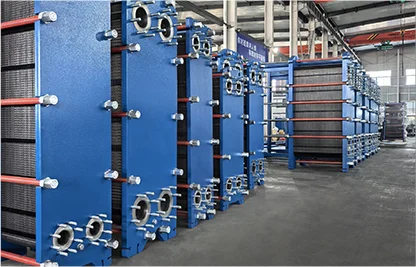Plate heat exchangers make heating systems super efficient by passing heat through thin, wavy metal plates, squeezing tons of surface area into a small space. The counterflow design and swirling flow crank up heat transfer, and Grano’s Sondex and API Schmidt-Bretten units are tough, low-maintenance picks for homes, factories, or green energy setups, saving money and running strong for years.

Principles of Plate Heat Exchanger Operation
Basic Mechanism of Heat Transfer in Plate Heat Exchangers
At the core of every plate heat exchanger lies a straightforward yet incredibly powerful process: heat moves through slim metal sheets by conduction and convection. These sheets are stacked side by side, creating tight passages. Two fluids, usually one warm and one cool, travel through these passages in alternating directions. As they flow on opposite sides of each sheet, warmth passes from the hotter fluid to the colder one through the thin barrier. Plate heat exchangers play a vital role in heating setups, allowing effective energy transfer between two substances at different temperatures using these narrow metal barriers that shape the flow paths.
The structure encourages strong swirling motion even at slower speeds, boosting the rate of heat movement. The fluids navigate through tight, winding routes between the sheets to swap thermal energy. This setup ensures the largest possible contact area between the fluids while using the least amount of material.
Flow Configuration and Its Impact on Thermal Efficiency
The effectiveness of heat transfer in a plate heat exchanger relies a lot on how the fluids are guided through the device. A counterflow setup, where the warm and cool fluids travel in opposite ways, creates bigger temperature gaps compared to a side-by-side flow. This pattern helps pull out more energy from the hotter stream before it leaves the unit.
The unique herringbone design pressed onto each sheet also makes a big difference. Since the sheets are placed in an alternating manner, countless tiny contact points from the crisscross pattern are spread out evenly. As a result, the fluid moves around these points, stirring up intense motion and leading to a remarkably high rate of heat transfer.
Importance of Turbulent Flow and Thin Plates for Heat Transfer Performance
Swirling motion isn’t just a side effect; it’s a deliberate part of the design. The ridged surfaces boost this motion even at low flow rates, breaking up stagnant layers and improving heat movement through convection. The surface of each heat exchange sheet is shaped with waves or grooves to make it sturdier, increase fluid disturbance, and enhance the overall heat transfer rate.
These thin metal sheets provide little resistance to heat while enduring tough pressures and high temperatures. They work well for various heat transfer needs under different conditions and are widely used in industries like heating, HVAC, chemical processing, and metalworking.
Key Design Features That Contribute to Thermal Efficiency
High Surface Area to Volume Ratio
One major benefit is their space-saving build. By layering many thin sheets close together, you get a huge surface area compared to the overall size. This allows for powerful energy transfer without needing bulky equipment.
They take up minimal room and are simple to install or remove. This makes them a great choice for updating older setups or fitting into tight spaces in mechanical areas.
Counterflow Arrangement for Maximum Temperature Differentials
The counterflow layout allows for temperature overlaps, where the exit temperature on one side can surpass the entry temperature on the other. This maximizes the heat transfer effect. Such a setup is especially useful in recovering low-level energy, where getting the biggest temperature difference is key.
This careful control over how fluids move makes modular designs so effective. You can adjust the flow paths to meet specific needs without having to overhaul the whole system.
Use of Chevron Plates and Gasket Technology
Chevron-patterned sheets aren’t just for looks; they’re built for results. Their V-shaped bumps create a spinning motion in the fluid, increasing disturbance while keeping the structure strong.
Gaskets do more than just seal the channels; they guide the fluid’s path. Placed around each sheet, they not only prevent leaks but also form small gaps between sheets, shaping the fluid routes. These seals need to handle pressure changes and harsh chemicals while staying flexible over time.
Application of Plate Heat Exchangers in Modern Heating Systems
Integration into District Heating Networks
District heating depends on central energy hubs that spread warmth across wide city areas. Plate heat exchangers act as key transfer points in this system, moving energy safely and effectively from main loops to smaller local networks.
Their small size allows them to fit into crowded basements of homes or businesses. Plus, they handle changing demands well, responding quickly to shifts in heat needs.
Use in Domestic Hot Water Systems and Central Heating Plants
In homes or large boiler facilities, these devices are essential. They keep household water separate from heating loops while ensuring fast temperature adjustments.
They’re used in many areas, from home heating to factory processes, thanks to their toughness and dependability. Their ability to manage varying needs makes them critical during high-demand times.
Role in Renewable Energy-Based Heating Solutions
As more setups use solar heat collectors or underground thermal loops, having efficient go-between exchangers is a must. Plate models can pull useful energy even from cooler sources because they’re highly sensitive to tiny temperature changes.
They adapt well to a wide range of temperatures, from mild underground inputs to solar systems reaching up to 200°C. This flexibility comes from strong materials like titanium alloy or stainless steel. Material options include stainless steel, titanium alloy, and carbon steel.
Grano’s Product Portfolio: Enhancing Efficiency with Advanced Plate Heat Exchangers
If you’re searching for top-notch solutions designed for both power and adaptability in HVAC or industrial fields, Grano is the name to trust. With years of skill in engineering, Grano offers finely tuned systems that meet worldwide needs without cutting corners.
Whether you’re improving an old setup or starting fresh, Grano’s experts provide helpful advice along with solid products. Their range covers everything from small home units to heavy-duty industrial models, all crafted to fit real-life uses.
Overview of Sondex Plate Heat Exchangers

Sondex plate heat exchangers are built for top performance, offering excellent heat transfer in a neat, small package. Their smart design ensures high swirling motion with low pressure loss while cutting down on buildup over long use.
Grano creates carefully made replacement sheets and complete units that match or surpass the original SONDEX standards. This ensures they fit smoothly into older systems or brand-new projects.
Learn more about Sondex options right here.
API Schmidt-Bretten Solutions for High-Performance Heating Applications
For tough settings like power stations or chemical plants that need custom setups, the API series delivers sturdy builds ready for extreme conditions.
The lineup includes models from Sigma13 to Sigma156, crafted for flexible use across a variety of heat demands.
See how API-Schmidt models can boost your system’s potential today.
Comparative Advantages of Grano’s Plate Heat Exchanger Solutions
Enhanced Energy Efficiency and Reduced Operating Costs
Thanks to clever ridge patterns and material choices, plate heat exchangers offer outstanding heat performance. They cut down on the power needed for pumps due to lower pressure drops. Plus, they deliver more output per square foot than older shell-and-tube styles, saving energy and lowering running costs.
Compact Footprint and Ease of Installation
Space limits often block upgrades, but not with these. Their small build saves room, and the detachable design makes cleaning and upkeep a breeze. Light frames make transport easy, while their modular nature allows gradual growth without stopping operations.
Long-Term Reliability with Minimal Maintenance Requirements
With the right setup steps, like aligning gaskets properly and tightening bolts evenly, along with regular checks, these units run smoothly for years. Routine care and good insulation can further improve their performance and lifespan.
Importance of Professional Service and Support from Grano
Technical Consultation and System Design Assistance
Every job comes with its own challenges, from flow speeds to rust risks. Getting expert advice early on helps dodge expensive mistakes. The plate heat exchanger should be put together based on the planned design layout.
Grano offers custom help from the first idea to the final setup, including detailed CAD plans tailored to your exact needs.
Scheduled Maintenance and Spare Parts Availability
From rubber seals to special titanium sheets, accessories include plates, gaskets, and bolts. With high-quality spare parts kept in local stock, you cut downtime during regular fixes or sudden repairs.
Performance Optimization Through Lifecycle Support
Constant tracking helps spot buildup before it turns into a problem. If scaling shows up on the sheets, they must be taken apart right away for cleaning. Grano’s ongoing services include regular checkups to keep your system running at its best, even as demands shift over time.
FAQ
Q: What causes mixing between hot and cold fluids inside a plate heat exchanger?
A: Mixing often happens when rust eats through one or more sheets, creating tiny holes. This is usually due to corrosion wearing down the material.
Q: How often should I perform maintenance on my unit?
A: How often you check depends on how hard the unit works, but looking it over every 6 to 12 months is a good rule. Regular care can boost both performance and how long it lasts.
Q: Can I use these exchangers with harsh chemicals?
A: Yes, as long as you pick the right materials like titanium alloys. They can handle hot, high-pressure settings with all kinds of fluids, even those that cause rust.






